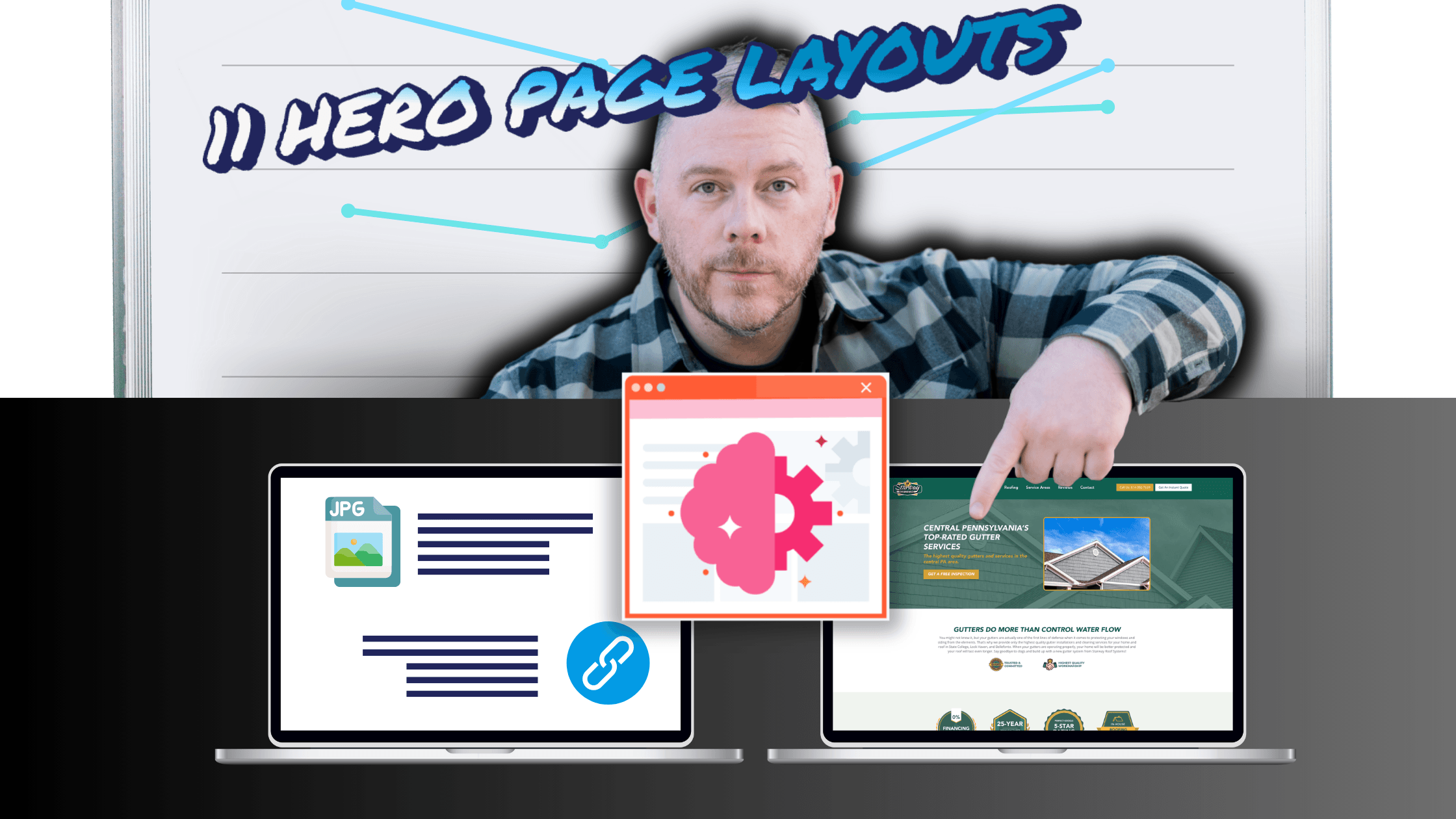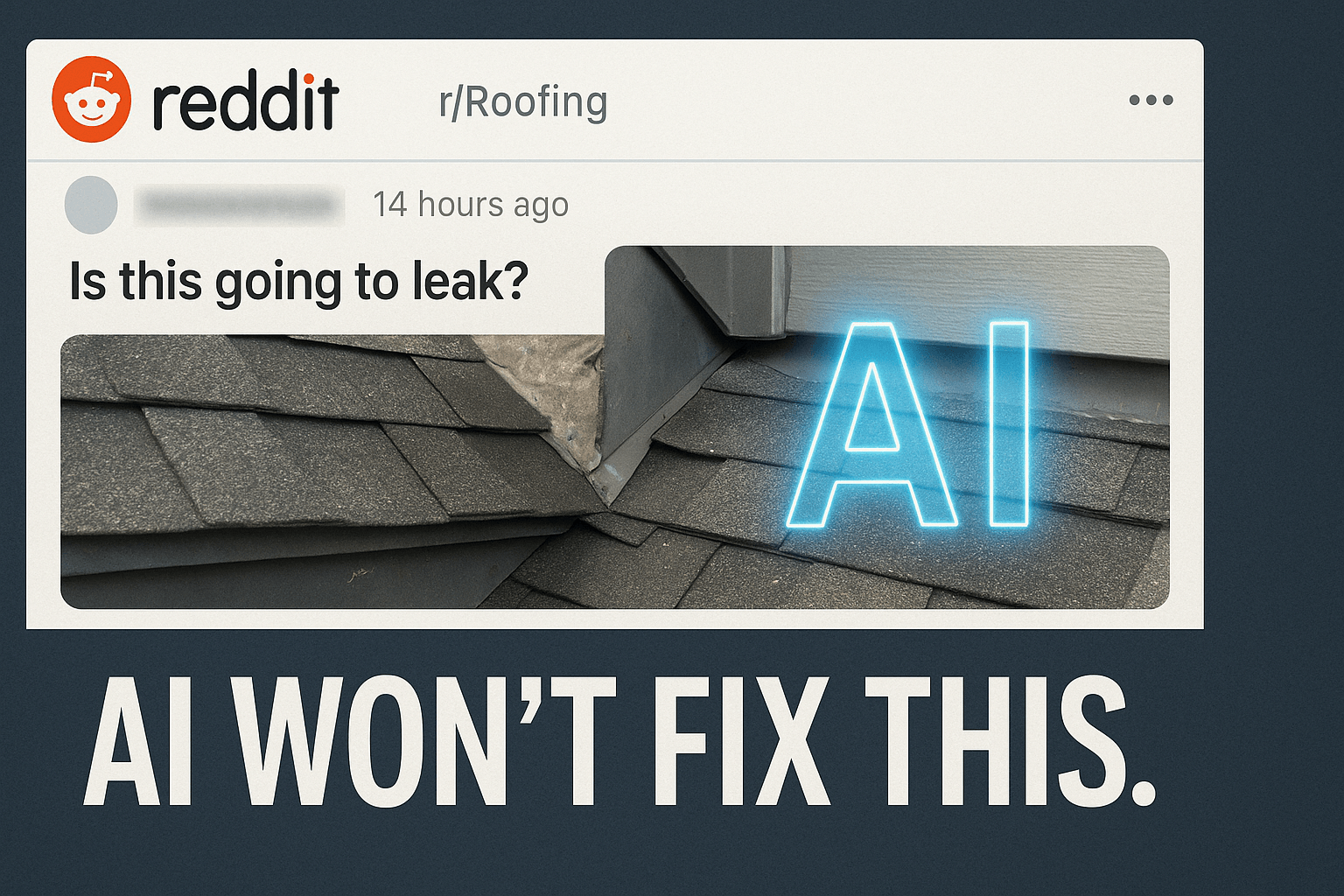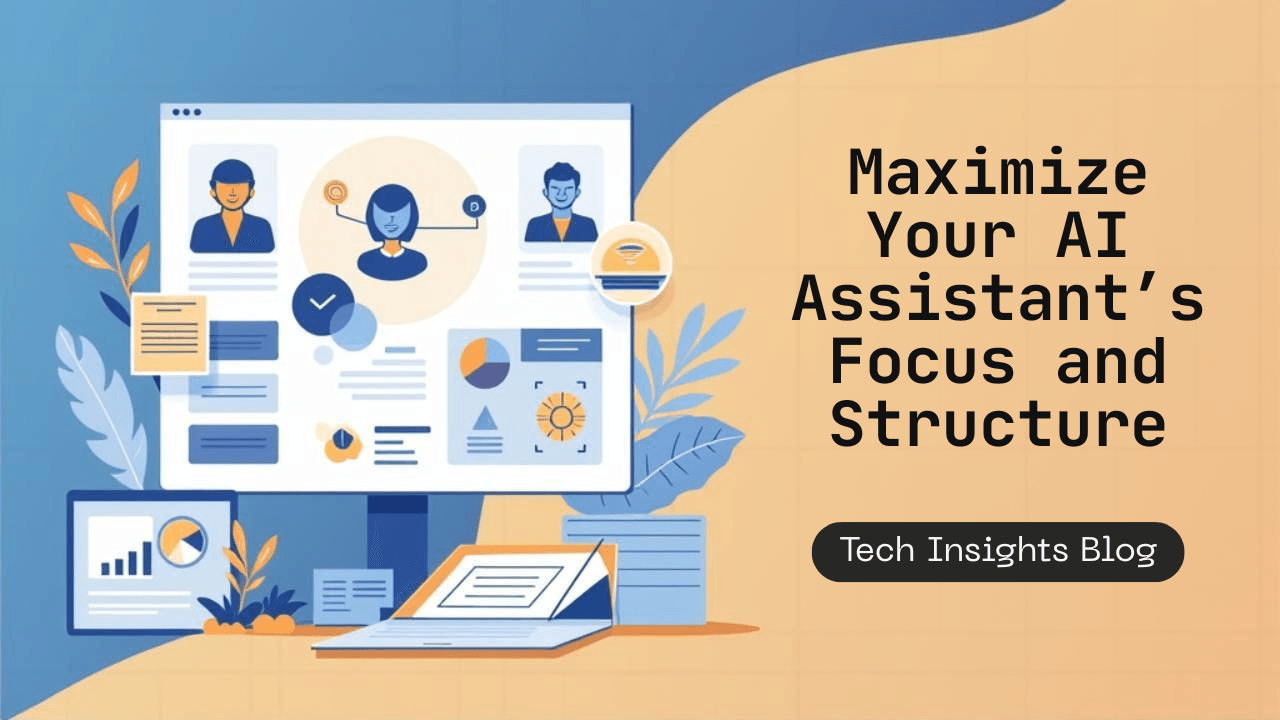Optimizing Your Roofing Website: 11 Hero Section Concepts
Stop Burning Ad Spend: 11 Roofing Website Hero Sections That Actually Convert The goal is simple: $300 leads, a 30% close rate, 40% gross profit, and...
11 min read
 Adam Sand
:
Nov 1, 2025 4:46:03 PM
Adam Sand
:
Nov 1, 2025 4:46:03 PM
TL;DR: Search is shifting from SEO to AEO (AI Engine Optimization). Treat your website like an“AI résumé.” Do a ruthless audit of your digital footprint, feed clean data to AI agents, generate a strategy, have a second model peer‑review it, apply your real‑world constraints (budget, seasonality), then ship a concise proposal + ROI model—ideally via an interactive chatbot that answers stakeholder questions 24/7.
The marketing landscape is always shifting. At one point, marketing meant having a storefront and hoping for foot traffic. Then came billboards, newspapers and the Yellow Pages. Radio and television offered new ways to capture attention. Google revolutionized search with ten blue links, followed by the explosive growth of social media and digital advertising on every platform.
While channels evolve, the fundamentals of good advertising do not: you must have the right message, in front of the right market, with a compelling offer. If you try to sell vintage Nike Air Jordans on Rodeo Drive, you will likely fail because the market isn’t right. Selling them in urban Chicago—the home of the Bulls—is a slam dunk. And if your Chicago billboard says “While Supplies Last” (scarcity) instead of just “On Sale Now” (opportunity), more people will take the next step. Finally, the path of least friction always wins: send them directly to the product page rather than your homepage.
These principles apply whether you’re selling sneakers or standing seam metal roofs. But in 2026 we are facing the most significant channel shift in two decades: the rise of AI‑powered search.
We are moving rapidly away from traditional Search Engine Optimization toward AI Engine Optimization. People are no longer just typing keywords into Google and clicking the top link. They are asking complex questions to tools like ChatGPT, Perplexity and Google’s AI Overview, such as:
“What’s the best roofing material for a lakefront home in Muskoka that can handle heavy snow?”
“Find me a trusted local contractor specializing in cedar shake installation.”
In this new world, your website is your AI résumé. You’re effectively applying to be part of the AI’s answer. The AI doesn’t care about keyword density; it cares about trust, accuracy, consistency and authority. Does the information on your site provide a comprehensive, factual answer? Does your Google Business Profile match the hours listed on your contact page? Consistency equals trust. Authority equals citation.
To grow your roofing business in 2026, you need an annual marketing plan built not for the algorithms of 2015, but for the AI engines of 2026. The process below details a data‑driven path to build a comprehensive plan, leveraging the best tools and methodologies available today.
Before you can build a plan, you must understand exactly what you have and how the digital world—and AI specifically—perceives you. This phase is about data aggregation and creating a snapshot of your current digital footprint.
Visualize Your Current State: use a tool or browser extension that can take a full‑page scrolling screenshot of your key pages (Homepage, Services, About Us). This provides a visual reference for analyzing user experience, branding consistency and calls to action.
Scrape and Analyze Your Content: extract every word from your website using a crawler like Firecrawl. Scrape service pages, blog posts, location pages and sitemaps (page‑ and post‑sitemap.xml). Export this data into clean Markdown or text files. This content inventory allows AI tools to analyze topical coverage, content depth, internal linking and areas where your expertise is thin.
Conduct an AEO Visibility Audit: run dozens of specialized prompts through major AI models (GPT‑4, Gemini, Perplexity). These prompts impersonate potential customers in your service area asking relevant questions (e.g., “I need a roof replacement in [City], [State]. I found [Your Company] online. What do you know about them?”). The resulting report provides a score for your share of voice across AI platforms, analyzes brand sentiment, identifies which competitors the AI mentions alongside you and highlights growth areas specific to AI citation.
Gather Business Context and Competitive Data: identify your top 3–5 competitors and analyze their positioning (price, quality, speed, specialization). Define your reality: annual revenue, target growth, average job value, closing rates, seasonality (peak months vs. slow months) and available marketing budget (often 5–10 % of gross revenue).
Once you have aggregated your data, it’s time to turn information into strategy. Advanced AI agents (like Gemini or specialized platforms like Manus) can accelerate your workflow, but prompt engineering is the difference between generic advice and a tailored strategy. You are not just asking the AI, “Give me a marketing plan.” You are providing it with all your data, defining its role and giving it a strict framework for the output.
Engineer the Master Prompt: start by telling the AI who it is (“You are an AI search optimization strategist specializing in the roofing industry…”). Clearly state the goal (“Create a comprehensive AI search optimization strategy that increases brand visibility and citations for [Your Company]…”). Paste the summaries of your content inventory, AEO audit findings and business context directly into the prompt. Provide the output framework to ensure a structured, comprehensive result.
Execute the Strategy Generation: the AI reads your website content, analyzes the AEO report and cross‑references this with its knowledge of AI behavior and roofing best practices to populate your framework. The output is a comprehensive (often 15–30‑page) strategy document detailing specific content to create, how to restructure existing pages for better AI parsing and how to build authority signals.
Master Prompt Template: use this as a starting point:
ROLE: You are an AI search optimization strategist (AEO) for roofing companies.
OBJECTIVE: Create a 12‑month AEO‑driven marketing plan that increases brand citations in AI answers and drives profitable booked jobs for [Company] in [City/Region].
INPUTS:
- Content inventory summary: [paste]
- AEO visibility audit highlights: [paste]
- Business constraints (revenue, budget, seasonality, targets): [paste]
- Competitors & positioning: [paste]
OUTPUT FRAMEWORK:
1) AI Engine Behavior (how GPT/Perplexity/Google summarize roofing topics in this region)
2) Target Query Map (commercial + informational, prioritized by revenue impact)
3) Authority Plan (E‑E‑A‑T assets, citations, GBP/NAP consistency, policy pages)
4) Content Plan (pages to create/upgrade, briefs, internal links, schema)
5) Conversion Paths (lowest‑friction CTAs, page‑to‑call flows, offer packaging)
6) Implementation Timeline (month‑by‑month)
7) KPIs (leading/lagging), Measurement & Cadence
8) Risks & Mitigations
Phase 3 — Validation & Peer Review (Two Brains Beat One)
The most robust strategies are those that have been challenged and validated. In an AI‑driven workflow, this means using a second AI agent to review the work of the first. This step significantly increases the quality and reliability of the strategy.
Generate a Second Opinion: take the exact same inputs (data and master prompt) from Phase 2 and feed them into a different AI model or platform. If you used Gemini first, use Manus or GPT‑4 next.
Conduct the AI Peer Review: instruct the second AI agent to act as a peer reviewer. Provide the first agent’s output and ask it to perform a detailed review compared to its own analysis. Encourage it to identify:
Convergent insights: where do both analyses agree? These become high‑confidence recommendations.
Unique contributions: what did Agent1 identify that Agent2 missed, and vice versa?
Discrepancies: where do the strategies conflict? Which recommendations should be prioritized?
Optimization: ask the agent to combine the best elements of both analyses into a single, superior strategy.
The output is a revised, synthesized strategy that is more comprehensive and validated than either report alone.
The output from Phase 3, an "Ultimate Solution"—a perfect-world strategy without budget limitations. Phase 4 brings this strategy down to earth, aligning it with your business reality.
Define the Guardrails: provide the AI agent with your specific financial and operational constraints:
Financial parameters: annual revenue (e.g., Financial parameters: annual revenue (e.g., $3M), total marketing budget (e.g., $150k), required gross margin (e.g., 40%). Define a monthly campaign budget range (e.g., $1k).
Seasonality: note when cash flow is tight (e.g., November through February) and when revenue peaks (e.g., June through August).
Strategic must‑haves: specify that the plan must include a website optimization phase and prioritize lead generation for your new metal roofing division.
Restructure the Plan: instruct the AI to revise the entire strategy to fit within these constraints. The AI will map the budget across 12 months, align spending with seasonal revenue, prioritize high-impact activities, and adjust content volume to match your capacity.
Create Tiered Options: request tiered investment options to provide flexibility:
Foundation Package: minimum viable plan to improve visibility and generate leads.
Momentum Package: a mid‑tier plan with increased content production and campaign spend.
Market Leader Package: the full program designed for aggressive growth and market dominance.
12‑Month Budget Skeleton: here’s a sample structure you can adapt:
This final phase transforms the internal plan into a compelling client‑facing proposal and introduces an innovative delivery method.
Model the Return on Investment: a strong proposal must demonstrate value. Provide the AI with your average project value (e.g., $15k), your net profit margin (e.g., 10%), and industry-standard close rates (e.g., 25%). Instruct the AI to use conservative assumptions to show realistic growth projections for Year 1 and beyond.
Format the Customer‑Facing Proposal: the proposal should be concise (2–5 pages), clear and focused on outcomes—not processes. Include the strategy, roadmap, investment options and ROI, but exclude internal margins, hourly breakdowns and proprietary methods. Simultaneously have the AI create internal documents: a detailed implementation guide, task breakdown with hours and cost analysis for your team.
Deliver via an Interactive Chatbot: instead of a static PDF, deliver the proposal via an interactive chatbot. The AI consolidates the entire proposal into a structured knowledge base. It builds a web interface where clients can ask questions like, “Why this strategy instead of just running Google Ads?” or “Can you explain the ROI projection for the Momentum Package?” The chatbot, constrained to discuss only client‑facing information, provides instant, accurate answers. This low‑pressure environment helps stakeholders explore the proposal on their own terms.
Avoid these pitfalls as you build your plan:
Homepage dumping: sending AI traffic or paid traffic to a generic homepage instead of a specific page with one next step. Friction kills conversions.
Inconsistent basics: your Google Business Profile says you’re open until 6; your site says 5. AI sees that and docks trust.
Thin “service” pages: 300 words and a stock photo won’t get cited by AI engines.
No authority assets: licenses, insurance certificates, warranties, safety policies, building‑code notes—publish them.
No peer review: one model ≠ truth. Cross‑check.
No constraints: great plans die when budget and seasonality aren’t baked in.
A successful plan is only as good as its measurement framework. Here’s a KPI set you can use:
Lead indicators:
- AI Share of Voice (% of AI answers citing/mentioning your brand on top 50 queries)
- Content coverage score (briefs shipped, pages upgraded, schema added)
- Local consistency score (Google Business Profile/NAP sync, hours/areas/services alignment)
- Technical health (Core Web Vitals pass rate, indexation, crawl errors)
Lag indicators:
- Qualified inbound calls/forms
- Booked appointments
- Close rate by channel
- Jobs by service line (average ticket, gross margin)
- Customer acquisition cost (CAC), Lifetime Gross Profit (LGP) and LGP:CAC ratio
When you create or optimize pages that you expect AI engines to cite, make sure they include:
Specific geography and climate conditions (snow load, lakefront wind, code notes).
Materials trade‑offs with numbers (lifespan, maintenance, warranty terms).
Process transparency (estimate → install → warranty).
Photos, before/after shots and job map markup.
A clear offer with a direct booking call to action—no homepage detours.
Scrape your site and export the text.
Run 25 buyer‑style prompts across GPT/Gemini/Perplexity for your market; log citations and mentions.
Build the Master Prompt with your inputs; generate the plan.
Run a second model, peer‑review and synthesize.
Recast with budget and seasonality; ship a 3‑tier proposal and ROI model.
Turn the plan into an interactive Q&A chatbot; send it to stakeholders.
Google prioritizes consistent local signals and helpful content. Optimize your Google Business Profile, collect reviews regularly, and ensure your website includes city-specific landing pages (e.g., “Roof Replacement in Kelowna, BC”). Focus on clear headlines, fast load speeds, and content that directly answers homeowner questions.
Short, visual, and trustworthy content: before-and-after project photos, quick educational videos, and blog posts that solve problems. Pair visuals with SEO-rich captions and city-based keywords. Roofers who do this consistently see organic traffic rise 25–40% within six months.
SEO builds authority and compounds over time; ads create speed. Smart roofers use both: ads keep leads flowing while SEO builds dominance. A 60/40 split (SEO to ads) usually maximizes profit over a 12-month period.
Track revenue-producing metrics inside your CRM: cost per lead (CPL), lead-to-close rate, and average deal size. If CPL is $150 and your close rate is 20%, your cost per sale is $750. Compare that to average job profit to measure ROI. Aim for a 4:1 revenue-to-cost ratio.
Most roofing sites fail at conversion optimization — missing CTAs, unclear trust signals, or slow pages. Add a visible quote button, customer reviews, and before/after galleries above the fold. Use tracking tools like Hotjar to see where visitors drop off.
AI can generate blog drafts, ad copy, or homeowner guides in minutes. Use it to brainstorm seasonal content (e.g., “How to prevent ice dams in Alberta”) or write email campaigns. Always localize and fact-check — AI amplifies your expertise; it doesn’t replace it.
Start with high-intent local terms such as 'roof repair near me', 'emergency roof leak [city]', and 'storm damage roofing company.' Then layer in value modifiers like 'affordable,' 'licensed,' and 'insurance approved.' Long-tail keywords convert best.
Absolutely. Google’s E-E-A-T standards reward companies that teach, not sell. Educational posts like 'How to Choose a Roof Color That Boosts Resale Value' attract both humans and AI models that summarize web answers.
They’re one of the strongest ranking signals for local search. Google factors in review volume, frequency, and replies. Aim for 5–10 new reviews per month, respond thoughtfully, and embed review widgets on your site to improve both trust and dwell time.
Use this framework: Hero headline (location + offer), Quick CTA (“Book Estimate”), Real team photo, Trust badges, Short testimonial slider. This mix of credibility and simplicity can raise conversion rates by 30% or more.
Compress large images, limit animations, and avoid bulky themes. Test your site in PageSpeed Insights and Lighthouse. Over 70% of roofing leads originate on mobile; every second of delay costs you engagement and revenue.
Conduct surveys or analyze insurance claim data. Post findings like “Average Roof Replacement Cost in Alberta (2025).” When other websites cite your data, they link to you — boosting authority. One high-quality study can earn dozens of backlinks.
A semantic triple expresses a factual relationship (Subject → Predicate → Object). Example: “Metal roofs → reflect → sunlight.” When embedded in schema or clearly structured sentences, they help search engines and AI understand your authority, improving visibility in voice and AI search.
Chunking means dividing long pages into digestible sections (150–300 words) with clear subheadings. AI models process these smaller segments efficiently, improving the chances your content appears in AI answers and featured snippets.
Yes. Larger models (like GPT-5 or Gemini 2) analyze more context, which rewards well-structured, detailed posts. Long-form, data-backed roofing pages are more likely to be accurately summarized by advanced AI models, increasing exposure.
Add structured metadata, author bios, and source links. Cite your own research clearly and use schema markup for “Article” and “FAQ.” AI crawlers prefer content that signals authority, original authorship, and transparency.
AI search tools now use vector embeddings that understand meaning, not just keywords. Roofers who structure content around ideas — not just phrases — will dominate AI-powered discovery. Focus on clarity, trust, and unique data.
FAQ schema is a special markup added to your web page that tells Google your page contains official answers to common questions. When used correctly, it can display your answers directly in search results — improving click-through rates by 20–30% and qualifying you for AI-generated answer cards in tools like Perplexity or ChatGPT.
How-To schema structures your step-by-step guides (e.g., “How to File a Roof Insurance Claim”) in a format AI systems understand. It helps your instructions appear as interactive results in Google and answer engines. When combined with clear visuals and trustworthy sources, it builds topical authority and increases dwell time — key signals for higher ranking.
This AI‑driven methodology for developing an annual marketing plan represents a significant leap forward in strategic planning. It moves beyond guesswork and generic templates, leveraging the power of data analysis, AI synthesis and iterative refinement. By adopting this approach, you are not just creating a marketing plan; you are building a system that understands the evolving landscape of AI search and positions your roofing company as the authoritative, trustworthy choice in your market. The result is a realistic, budget‑constrained and validated strategy designed to deliver measurable growth in 2026 and beyond.

Stop Burning Ad Spend: 11 Roofing Website Hero Sections That Actually Convert The goal is simple: $300 leads, a 30% close rate, 40% gross profit, and...

1 min read
Most roofers do not know how to "Buy" AI. Think of a home owner, every 3-5 hours there is a post on Reddit on the r/roofing subreddit where a home...

Artificial Intelligence (AI) assistants, like ChatGPT, can be tremendously helpful in managing complex projects—serving as brainstorming partners,...